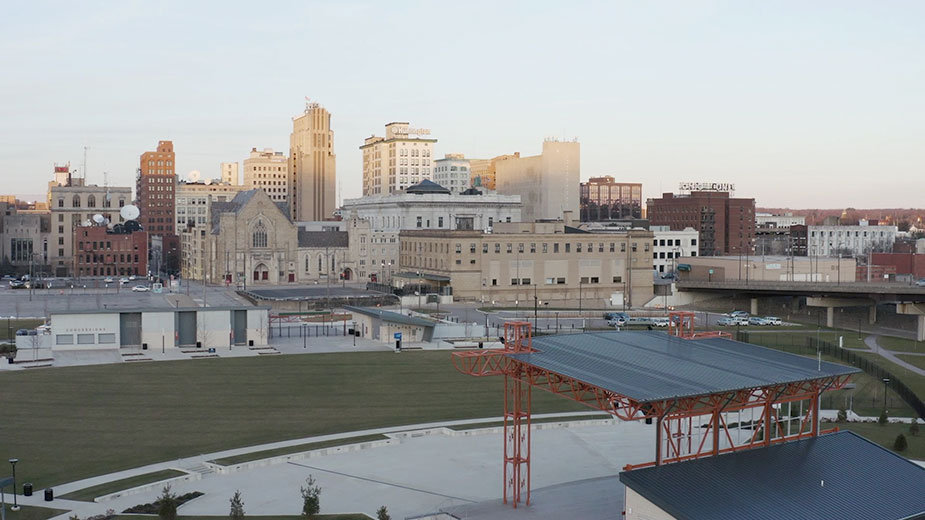YOUNGSTOWN, Ohio – Leaders of the Youngstown/Warren Regional Chamber and Eastgate Regional Council of Governments report they are making progress on a repopulation strategy for the Mahoning Valley aimed at meeting future workforce needs and they envision rolling out components of that strategy by the end of the year.
The initiative is driven by projections that show an additional 3,000 to 5,000 jobs will be available in the region by 2026, a figure that could grow to 20,000 by 2030, James Kinnick, executive director of Eastgate, says.
“A lot of jobs are going to come online around the 2026 timeframe,” Guy Coviello, president and CEO of the Regional Chamber, says. “And we anticipate that they’re going to be consistently coming online through 2030 and maybe beyond.”
Unfortunately, the area lacks the population to fill those jobs. People leave the area at a rate of about seven per day, Kinnick says.
“We have to grow the population to be competitive,” Coviello says.


“We would aggressively like to have the framework for an office of repopulation by the end of the year,” Kinnick says. “That is aggressive but we’re going to throw our resources out to make that happen.”
Eastgate recently was awarded $279,000 from the Ohio Governor’s Office of Appalachia to chart the repopulation strategy, Kinnick says. Using those funds, Eastgate engaged Envision, a Cleveland consulting firm that has been working with Eastgate on planning related to the Infrastructure, Investment and Jobs Act, and weekly meetings are underway.
“Right now it’s just strategies but we will move forward quickly and, hopefully start rolling out some of the ideas,” Kinnick says.
Components being assembled include resources to provide information about the Valley in one online location and an office of repopulation that would help immigrants.
The partners are pursuing what Kinnick describes as a “three-pronged strategy” to retain the Valley’s young people and talent, encourage talented young people to return and receive immigrants and refugees into the Valley to help fill those openings and repopulate the Valley.
“We’ve always felt that internal marketing was important to stop people from leaving,” Coviello says. That means not just targeting high school and college graduates and other young people but also their parents, teachers and guidance counselors to get them to stop telling kids they need to leave the area to succeed.
External marketing also is a “critical tool” to encourage people to move here, he says.
Only recently have efforts focused on immigration. And that could be various channels to legally bring people here to take jobs, raise families, pay taxes.
Emphasis on the quality of life is key, Kinnick says. Local assets he points to include “first-class health services” and the low cost of living.
Companies often cite quality of life as among the challenges they confront when they seek to attract talent, Coviello says. Candidates for positions want to know about the quality of the housing stock, recreational opportunities, education and health care.
“If you do a Google search for Youngstown, you’re going to get a lot of things that are not things that we want the world to see,” he says. “We want people to Google Youngstown and land on this page that tells wonderful things about our community.”
The chamber is working to develop such a website, Coviello says. While some information can be found on local websites, there is “no one place that you can go” for the broader range of information about the community.
“It’s out there. But it’s not … consolidated into one place,” Coviello says. “And when you’re trying to attract people here, they’re going to do their due diligence before they decide whether they want to come here to take the job.
“And they are not going to go from one site to the next to the next,” he continues. “It’s got to be one location where they can go learn all about our community.”
There is a recognition that enough isn’t done to promote Valley attractions, including Covelli Centre, Mill Creek Park and the downtown amphitheaters in both Youngstown and Warren, as well as the community’s proximity to Cleveland and Pittsburgh to attend major sporting events and concerts, Kinnick says.
Eastgate took the lead role to enhance an emerging local asset, the Mahoning River, where two dams have been removed; three are coming out this year and two more are scheduled for removal in the next two years.
“The numbers certainly sell themselves when you look at other communities that had rivers through their towns,” Kinnick says. Removal of the dams could lead to opportunities for housing and business attraction. So part of the focus as the partners seek additional ARC funding will be to secure money to capitalize on the river by creating “those downtown opportunities along the river.”
The partners also look to create an “office of repopulation” that will offer a “full circle of services” to the immigrants and refugees who come to the Valley, Kinnick says. Envision is working with a team of immigration attorneys as well as with Global Cleveland, which focuses on connecting immigrants to opportunities in northeastern Ohio.
“There’s no intent to reinvent the wheel here. We’re going to follow a proven path. We just hope to accelerate that path,” Kinnick says.
“A welcoming center is going to be needed because the people that come here may not understand our way of life,” he says, covering aspects of American life such as securing financing to buy a house or car and how or where to go to school.
One big cultural difference between the United States and war-torn Ukraine, which is a focus of local immigration outreach, is there are no mortgages or car loans. So borrowing for a car or house is a “completely foreign concept,” Coviello says. “And that is just one country.
“When you talk about immigration from other counties, the cultural barriers and differences are all unique. And then the rules are all unique,” he says. “So, the immigration attorneys become a big part of what we’re trying to do in cooperating with employers.”
The partners also are seeking funds to hire a consultant to assess housing in Mahoning and Trumbull counties.
“People don’t realize what a challenge that’s going to be. But we really do need to add to our housing inventory,” Coviello says. “If we’re going to grow the population, there has to be places for that population to live.”
Depending on where the new population comes from, housing to meet their needs could take a different shape from what the Valley is accustomed to. It will require changes in local building and zoning codes to accommodate options such as multi-unit complexes in communities that traditionally have discouraged such development, Coviello says.
As opposed to previous generations who wanted large lot sizes, some of these new residents want to take care of “as little as possible.” Demand for apartments is high in downtowns such as Youngstown and Warren.
“All of the downtowns have opportunities to grow in terms of residential,” he says.
The chamber is working with Eastgate to secure as much funding as possible to take repopulation plans to the next level.
“The focus is heavily on the river corridor and completing the revitalization of the river [and enhancing quality-of-life opportunities along it], “which fits well with what we’re hearing from young talent that might come and stay here,” Coviello says.
